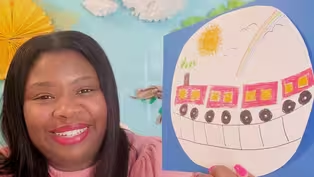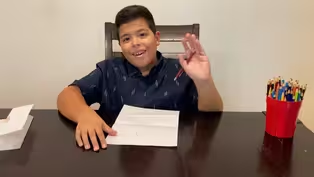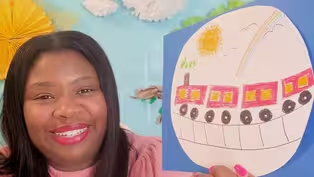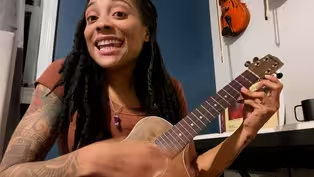
DIGRAPHS CH AND SH
Clip: 4/20/2023 | 11m 2sVideo has Audio Description, Closed Captions
Isabel Simmons helps children learn about the digraphs sh and ch.
Isabel Simmons shows children how to build, spell, and read words with the digraphs sh and ch. Digraphs are two letters that represent one sound.
See all videos with Audio DescriptionADProblems playing video? | Closed Captioning Feedback
Problems playing video? | Closed Captioning Feedback
Let's Learn is a local public television program presented by THIRTEEN PBS

DIGRAPHS CH AND SH
Clip: 4/20/2023 | 11m 2sVideo has Audio Description, Closed Captions
Isabel Simmons shows children how to build, spell, and read words with the digraphs sh and ch. Digraphs are two letters that represent one sound.
See all videos with Audio DescriptionADProblems playing video? | Closed Captioning Feedback
How to Watch Let's Learn
Let's Learn is available to stream on pbs.org and the free PBS App, available on iPhone, Apple TV, Android TV, Android smartphones, Amazon Fire TV, Amazon Fire Tablet, Roku, Samsung Smart TV, and Vizio.
Providing Support for PBS.org
Learn Moreabout PBS online sponsorship[cheerful folk music] [imitates train chugging] - [gasps] Hi, friends.
Welcome to the land of digraphs.
My name is Isabel.
And today, we're gonna learn that digraphs are two letters that make one sound.
Did you see what I did there?
That's right.
Two letters that make one sound.
We're gonna be learning about the C-H digraph that says ch, like chin, and the S-H digraph that says sh, like ship.
Are you ready to read and write with me?
- [Children] Yeah!
- Great.
Let's get started.
Our first activity is going to be a listening activity.
So before we even get started, we have to warm up our ears.
Are you ready?
Get those cranks.
[bright xylophone music] Warm them up.
Warm them up.
Are they ready?
Great.
We're going to be listening to sounds.
You're going to repeat those sounds.
And then together, we're going to say the word.
Let's try one together.
Ch, ee, z.
Your turn.
Ch, ee, z.
Cheese.
What's the word?
Cheese.
Good job.
Let's try that again.
M, uh, n, ch.
Your turn.
M, uh, n, ch.
Munch.
Mm.
Great job.
Let's try another one.
B, r, uh, sh.
B, r, uh, sh.
Brush.
What's that word?
Brush.
Here's the last one.
Are you ready?
Sh, e, l, f. Sh, e, l, f. Shelf.
Shelf.
I put books on my shelf.
What do you put on yours?
I think we're all warmed up.
Are you ready to build some words with me?
- [Children] Yeah!
- I love building words, and I love being in the land of digraphs.
Remember, digraphs are two letters that make one sound.
You got it.
And we're gonna start with the digraph, C-H.
So even though they're two separate letters, they're working together to say one sound.
Do you remember what that sound is?
That's right.
Ch.
So I can say, ch, o, p. And then I can move this closer and say, cho, p. Chop.
What's that word?
Chop.
That's right.
And I... Now if I know that that says chop, what will this say?
S-H says, sh.
That's right, sh.
Sh, o, p. Shop.
Like when I go and pick up food from the store.
Hmm.
What would happen if I changed the O that says o to the I that says i?
What's my word now?
Always go back to my digraph.
Sh, i, p. Ship!
Great job.
And if I change my digraph, what's my new word going to be?
Ch, ip.
Chip, like a potato chip.
Mm, yummy.
Sometimes digraphs are at the end of words, though, like in this word.
What do I do now?
I know that this says i, n, ch.
In, ch, inch.
Did you know that the tip of your thumb to about the middle of your thumb is about an inch long?
Who knew?
Inch.
And what happens if the S-H digraph that says, sh, is at the end of the word?
Let's see.
What happens then?
Hmm.
How will I read this word?
M, a, sh.
Ma, sh.
What's that word?
Mash.
Like when you squish something, like when you mash potatoes.
Mashed potatoes, mm.
Chips, mashed potatoes.
I'm really hungry.
But before we eat, we're ready to read.
Are you ready?
Me, too.
Let's get started.
Now that we've built some words together, we're ready to read some words.
But before we begin to read, I want you to look at the first line and ask yourself a question.
Where do I see the digraph?
Do I see the digraph at the beginning of the word or at the end of the word?
That's right.
I see it at the end of the word.
This is going to help me as I sound out each word.
I want you to get ready.
Let's start with this one.
Ash.
Cash.
Gash.
Oh, a gash is a cut that you might get.
Mash.
You knew that one.
Smash.
If you can read mash, you can read smash.
Good job.
[Isabel clapping] Let's go to the second line.
I want you to look at the second and the third line.
They have a lot in common.
Where do we see the digraph, in the beginning or the end of the words?
The beginning this time.
And are the digraphs the same?
They are.
Which digraph is it?
C-H. What does C-H say again?
Ch.
You're going to read out loud and I'm going to whisper read.
Chat.
Chant.
Chap.
Champ, like a winner.
Chip.
Chimp.
Good job.
Now we're ready for the last two lines.
Sometimes the digraph is at the end and sometimes it's at the beginning.
Are you ready?
Mush.
Much.
Chum.
Shun.
Shut.
Good job.
Mush reminds me of porridge or oatmeal.
A chum is a friend.
And when you shun someone, you turn away from them.
That might make someone sad.
Are you ready to read our sentence?
Come on, let's go.
I pay cash for my lunch.
Do you?
You did a great job reading.
Now we're going to build.
We're going to write two words.
So I want you to get a paper, or something to write on, and a pen or pencil, or something to write with.
And meet me right back here.
Right back.
You ready?
[playful music] Are you ready to write?
- [Children] Yeah!
- Great.
I'm gonna say a word, you're gonna repeat the word, and then together, we're going to sound the word out.
And then you're gonna write, and then I'll write.
The word is fish.
What's the word?
Fish.
Let's sound it out together.
F, i, sh.
Okay, are you ready to write?
Get started.
Mm-hmm.
Looking good.
Nice.
My turn.
Is this what you wrote?
F, i, sh.
You wrote that, too?
Great.
Thank you so much, friends, for taking this trip with me to the land of digraphs, especially the digraph that says sh, S-H, and C-H that says, ch.
Keep a lookout for both of those digraphs.
Listen for them.
Look for them.
And until next time, friends, happy reading.
Bye.
Video has Audio Description, Closed Captions
Clip: 6/12/2023 | 9m 2s | Darlene Thomas reads LOVE ON A PLATE by Kashin Kheiriyeh. (9m 2s)
Video has Audio Description, Closed Captions
Clip: 4/20/2023 | 8m 11s | Cassondra Easterling tests the speed of toy cars on a ramp. (8m 11s)
DANIEL TEACHES HOW TO MAKE POP-UP ART!
Video has Audio Description, Closed Captions
Clip: 4/20/2023 | 1m 9s | Daniel teaches how to make pop-up art. (1m 9s)
Video has Audio Description, Closed Captions
Clip: 4/20/2023 | 9m 2s | Darlene Thomas reads LOVE ON A PLATE by Kashin Kheiriyeh. (9m 2s)
Video has Audio Description, Closed Captions
Clip: 4/20/2023 | 6m 33s | Caitlyn McCain from NYC Children’s Theater takes children on an imaginative boat adventure (6m 33s)
Video has Audio Description, Closed Captions
Clip: 4/20/2023 | 10m 14s | Arielle Lewis from Education Through Music sings about the ways we travel to school. (10m 14s)
Video has Audio Description, Closed Captions
Clip: 4/20/2023 | 8m 58s | Eve Towsend notices the shapes of transportation vehicles. (8m 58s)
Providing Support for PBS.org
Learn Moreabout PBS online sponsorshipSupport for PBS provided by:
Let's Learn is a local public television program presented by THIRTEEN PBS


















